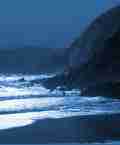 |
Search the site:

Walking Irelandís MountainsWICKLOWAt Glendalough, there is a noble CASCADE; the Lake thereof, is bounded on three Sides by vast, high and almost inaccessible mountains, that on the west Side is of a prodigeous height. Through the middle part there glides a smart River, from one Rock to another, descending nearly a mile before it enters the Lake at the Foot of the Mountain ... but what is surprising, the Natives affirm, that it passes through that Lake without mixing with its waters. James Weeks, A New Geography of Ireland, 1752This region of granitic mountains stretches in a long (fifty kilometres, thirty miles), broad line south-west from the outskirts of Dublin. As such it is the largest area of upland in Ireland and encompasses much fine walking country, part of it attractively remote, though other parts are gently shelving and bleak. It is particularly suited for long, but not over-strenuous walks. As an indication of its importance as a high amenity area close to a major city, some of the eastern side of the range is now in the Wicklow Mountains National Park and it is planned that more will be in the future. The popular Wicklow Way runs south from Dublin through a long stretch of this eastern side. Animal lovers - and others - will be impressed by the herds of deer, mostly sika and hybrids of sika and red deer, which roam the entire upland area. Of course, there are problems. In spite of its extent, access to open mountain is restricted in some, though only some, places. Forestry covers parts of several mountain valleys and even extends high into the hills; forestry tracks, though plentifful, are not routed to facilitate access. Near Dublin, farmland may also block access. In this area farmers have suffered constant trespass and so do not welcome walkers, well-intentioned or not. This is therefore an area where guidebooks are particularly useful to avoid access difficulties. Not entirely unrelated to its proximity to Dublin, walkers should not leave valuables in their cars. In recent years there has been a constant stream of break-ins to unattended cars in remote, and not so remote areas of the mountains. There are two marathon walks in the Wicklow Mountains. The Lug Walk, at fifty-three kilometres/thirty-three miles, is the longest but not the toughest marathon in Ireland; it takes place in]une of every odd-numbered year. On even-numbered years the somewhat shorter Glen of Imaal marathon takes place in the south-west of the region. In the very north, the mountains of County Dublin bear much evidence of the city's proximity in the form of masts, littering and eroded paths. Though broken by some pleasant glacial valleys and with hills rising gently to a considerable 757 metres/2,475 feet at Kippure (route 16), this northern end is mostly a plateau or shelVing moorland. In contrast, close to the city (and the sea) are Bray Head and the Sugar Loafs (routes 27, 28); they are low (Great Sugar Loaf rises to only 501 metres I I ,654 feet) but craggy and give short but energetic strolls. South of Kippure the granitic north-east to south-west spine is more evident. The three highest mountains in the range lie along it, all three sheltering high, attractive corries. These peaks are Mullaghcleevaun (847 metres/2,688 feet), which is con≠nected southward to Tonelagee (817 metres/2,686 feet) by high-level moorland, south of which is Lugnaquillia (925 metres/3,039 feet), the only Munro in the range. The moorland south of Mullagheleevaun is exceptionally wet and in parts riven by deep gullies interspersed by peat hags, the latter a feature of much of the lower-lying areas between the hills in this entire range. South of Lugnaquillia the general height is much lower, with pleasant, quiet, wooded valleys interspersed between the higher ground (routes 23, 25). The next Wicklow extract from Walking Ireland's Mountains can be found here: Part 2
|
[ Back to Top ]
All Material © 1999-2004 Irelandseye.com and contributors
